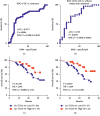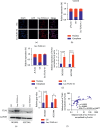Long Noncoding RNA Lnc-TLN2-4:1 Suppresses Gastric Cancer Metastasis and Is Associated with Patient Survival
- PMID: 32256587
- PMCID: PMC7086451
- DOI: 10.1155/2020/8681361
Long Noncoding RNA Lnc-TLN2-4:1 Suppresses Gastric Cancer Metastasis and Is Associated with Patient Survival
Abstract
Gastric cancer (GC) is one of the most common malignancies worldwide, and the tumor metastasis leads to poor outcomes of GC patients. Long noncoding RNAs (lncRNAs) have emerged as new regulatory molecules that play a crucial role in tumor metastasis. However, the biological function and underlying mechanism of numerous lncRNAs in GC metastasis remain largely unclear. Here, we report a novel lncRNA, lnc-TLN2-4:1, whose expression is decreased in GC tissue versus matched normal tissue, and its low expression is involved in the lymph node and distant metastases of GC, as well as poor overall survival rates of GC patients. We further found that lnc-TLN2-4:1 inhibits the ability of GC cells to migrate and invade but does not influence GC cell proliferation and confirmed that lnc-TLN2-4:1 is mainly located in the cytoplasm of GC cells. We then found that lnc-TLN2-4:1 increases the mRNA and protein expression of TLN2 in GC cells and there is a positive correlation between the expression of lnc-TLN2-4:1 and TLN2 mRNA in GC tissue. Collectively, we identified a novel lncRNA, lnc-TLN2-4:1, in GC, where lnc-TLN2-4:1 represses cell migration and invasion. The low expression of lnc-TLN2-4:1 is associated with poor overall survival rates of GC patients. These suggest that lnc-TLN2-4:1 may be a tumor suppressor during GC metastasis.
Copyright © 2020 Yuyun Wu et al.
Conflict of interest statement
The authors declare that they have no conflicts of interest.
Figures




Similar articles
-
A novel positive feedback regulation between long noncoding RNA UICC and IL-6/STAT3 signaling promotes cervical cancer progression.Am J Cancer Res. 2018 Jul 1;8(7):1176-1189. eCollection 2018. Am J Cancer Res. 2018. PMID: 30094092 Free PMC article.
-
Tumor suppressor lnc-CTSLP4 inhibits EMT and metastasis of gastric cancer by attenuating HNRNPAB-dependent Snail transcription.Mol Ther Nucleic Acids. 2021 Feb 10;23:1288-1303. doi: 10.1016/j.omtn.2021.02.003. eCollection 2021 Mar 5. Mol Ther Nucleic Acids. 2021. PMID: 33717650 Free PMC article.
-
Plasma Exosomal Long Noncoding RNA lnc-SLC2A12-10:1 as a Novel Diagnostic Biomarker for Gastric Cancer.Onco Targets Ther. 2020 May 11;13:4009-4018. doi: 10.2147/OTT.S253600. eCollection 2020. Onco Targets Ther. 2020. PMID: 32494155 Free PMC article.
-
Overexpression of lncRNA IGFBP4-1 reprograms energy metabolism to promote lung cancer progression.Mol Cancer. 2017 Sep 25;16(1):154. doi: 10.1186/s12943-017-0722-8. Mol Cancer. 2017. PMID: 28946875 Free PMC article.
-
Long non‑coding RNAs, lipid metabolism and cancer (Review).Exp Ther Med. 2023 Aug 17;26(4):470. doi: 10.3892/etm.2023.12169. eCollection 2023 Oct. Exp Ther Med. 2023. PMID: 37664674 Free PMC article. Review.
Cited by
-
Seven-Gene Signature Based on Glycolysis Is Closely Related to the Prognosis and Tumor Immune Infiltration of Patients With Gastric Cancer.Front Oncol. 2020 Sep 18;10:1778. doi: 10.3389/fonc.2020.01778. eCollection 2020. Front Oncol. 2020. Retraction in: Front Oncol. 2024 Sep 17;14:1490596. doi: 10.3389/fonc.2024.1490596. PMID: 33072557 Free PMC article. Retracted.
-
LncRNA LINC00342 contributes to the growth and metastasis of colorectal cancer via targeting miR-19a-3p/NPEPL1 axis.Cancer Cell Int. 2021 Feb 15;21(1):105. doi: 10.1186/s12935-020-01705-x. Cancer Cell Int. 2021. PMID: 33588834 Free PMC article.
-
Investigating the role of LncRNA PSMG3-AS1 in gastric cancer: implications for prognosis and therapeutic intervention.Cell Cycle. 2023 Oct;22(19):2161-2171. doi: 10.1080/15384101.2023.2278942. Epub 2023 Dec 5. Cell Cycle. 2023. PMID: 37946320 Free PMC article.
-
The molecular mechanisms of the long noncoding RNA SBF2-AS1 in regulating the proliferation of oesophageal squamous cell carcinoma.Sci Rep. 2021 Jan 12;11(1):805. doi: 10.1038/s41598-020-80817-w. Sci Rep. 2021. PMID: 33436941 Free PMC article.
-
Role of Metastasis Suppressor KAI1/CD82 in Different Cancers.J Oncol. 2021 Jul 9;2021:9924473. doi: 10.1155/2021/9924473. eCollection 2021. J Oncol. 2021. PMID: 34306081 Free PMC article. Review.
References
LinkOut - more resources
Full Text Sources
Miscellaneous

